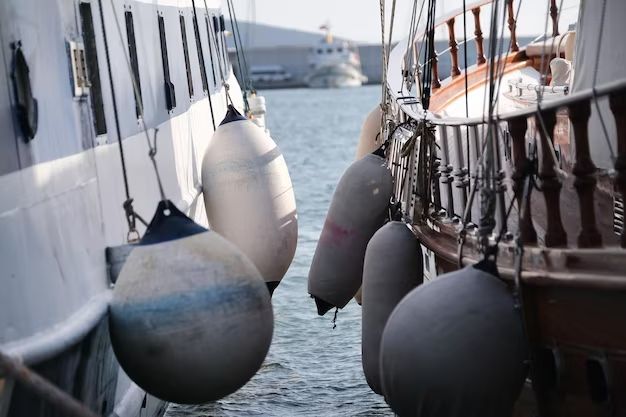Boat fenders are an important piece of equipment to have on any boat. They protect the boat from damage when docking or rafting up to other boats. Properly storing boat fenders helps keep them in good condition and easily accessible when needed.
Page Contents
What are Boat Fenders?
Boat fenders, also called dock bumpers, are protective cushions that absorb impact and prevent damage to the boat. They are made of soft, compressible materials like plastic, rubber, or foam. Boat fenders hang over the side of the boat and act as a buffer between the boat and docks, piers, or other boats.
There are several common types of boat fenders:
- Cylindrical or round fenders – These classic tube-shaped fenders work well for most applications.
- Half-cylinder fenders – Designed to fit onto narrow bows and sterns.
- Diamond or square-shaped fenders – Good for distributing pressure across flat surfaces.
- Cone fenders – Designed specifically for low freeboard areas.
Fenders are typically available in lengths ranging from 12 inches to 72 inches. The larger the boat, the larger fenders it will need. They are also rated for how much compression they can handle. Higher end fenders may have ratings of up to 1800 pounds of compression force.
Why Properly Storing Fenders Matters
Like any other boat equipment, fenders need proper storage and care for optimal longevity. Here are some key reasons why it’s important to stow fenders correctly:
- Prevent damage and deterioration – Long term exposure to sun, rain, saltwater can cause fenders to degrade, crack, or come apart prematurely.
- Keep them clean – Storing inside or with coverage prevents dirt, gunk, and stains from building up on fenders over time.
- Ensure accessibility – Fenders need to be easily reachable in order to be quickly deployed when docking or rafting up.
- Free up space – Deck space is valuable, so keeping fenders neatly stowed opens it up for other uses.
- Improve aesthetics – No one wants ugly, dirty fenders marring their boat’s looks when not in use.
Fender Storage Options
There are a variety of storage solutions and configurations for keeping fenders safe, clean and handy aboard boats. Which option is best depends on the boat, how many fenders there are, and personal preference.
Dock Lines
The most basic method is hanging fenders from dock lines at the deck or lifelines when not in use. This leaves them easily accessible for quick deployment. However, it exposes the fenders fully to the elements and can look cluttered.
Fender Clips
Fender clips offer a compact storage solution while still keeping fenders visible and available. The two-piece clips connect to rails or stanchions. Fenders slide into the ring portion, securing them in an upright position. Clips are quick to mount in any orientation and inexpensive.
Fender Racks
Mounted fender racks provide organized storage for multiple fenders. They are typically stainless steel or plastic trays with vertical tubes to insert fenders into. Racks can be mounted virtually anywhere but are commonly found at the bow, stern, and amidships gunwales.
Locker Storage
Stowing folded fenders inside deck lockers, lazarettes or other compartments offers full protection. However, this makes them less accessible. It’s best for boats that don’t require frequent fender deployment. A locker with internal racks or clips helps organize them.
Deflated Storage
Inflatable fenders can be stored while deflated in a locker to save huge amounts of space. This works well for boats with limited storage. It just requires more time and effort for inflation before use.
Fender Deployment Tips
Once fenders are neatly stowed, here are some tips for smooth deployment when coming alongside docks or other boats:
- Use enough fenders to fully protect the boat with a little overlap from end to end.
- Position fenders to absorb impact at the boat’s most vulnerable points – typically the widest midsection.
- Angle fenders about 45 degrees outward to deflect vessels away rather than pinching between.
- Keep extra fender lines accessible in case of need to reposition or add more.
- Consider using fender boards under larger cylindrical fenders to spread pressure across a wider surface.
- Inspect fenders after each use for any damage before re-stowing.
Fender Maintenance
With regular use, boat fenders will show signs of wear and tear over time. Following some basic maintenance steps will extend their longevity.
- Rinse fenders with fresh water after use to remove salt, dirt and grime buildup.
- Allow fenders to air dry fully before stowing to prevent mildew.
- Check for signs of brittleness, cracks, or tearing in the outer material.
- Inflate air-filled fenders to recommended pressure monthly if needed.
- Treat wooden rubbing surfaces on occasion with a protecting oil or wax.
- Replace heavily faded, damaged or non-functioning fenders.
Top Fender Brands
Well-known marine brands that manufacture quality fenders include:
| Brand | Notable Features |
|---|---|
| Taylor Made | Variety of sizes and shapes, molded-in colors, high density plastic or rubber |
| Davis | Classic styles, time-tested designs, vinyl covers |
| West Marine | Affordable prices, ultrasuede covers on some models |
| Polyform | Loaded with features, premium materials, customizable logos |
| Shoreline Marine | Durable vinyl covers, low cost, basic cylindrical shapes |
When selecting fenders, match them to the size of the boat, typical docking scenarios, and budget. Investing in quality from reputable brands will pay off over time.
Key Takeaways
Proper fender storage helps protect them from damage, keeps them looking good and makes them readily available when cruising. There are several storage methods and locations to choose from depending on preferences and boat configuration. Taking time to correctly deploy fenders before docking is also crucial. With routine care and maintenance, quality fenders should provide years of service.
